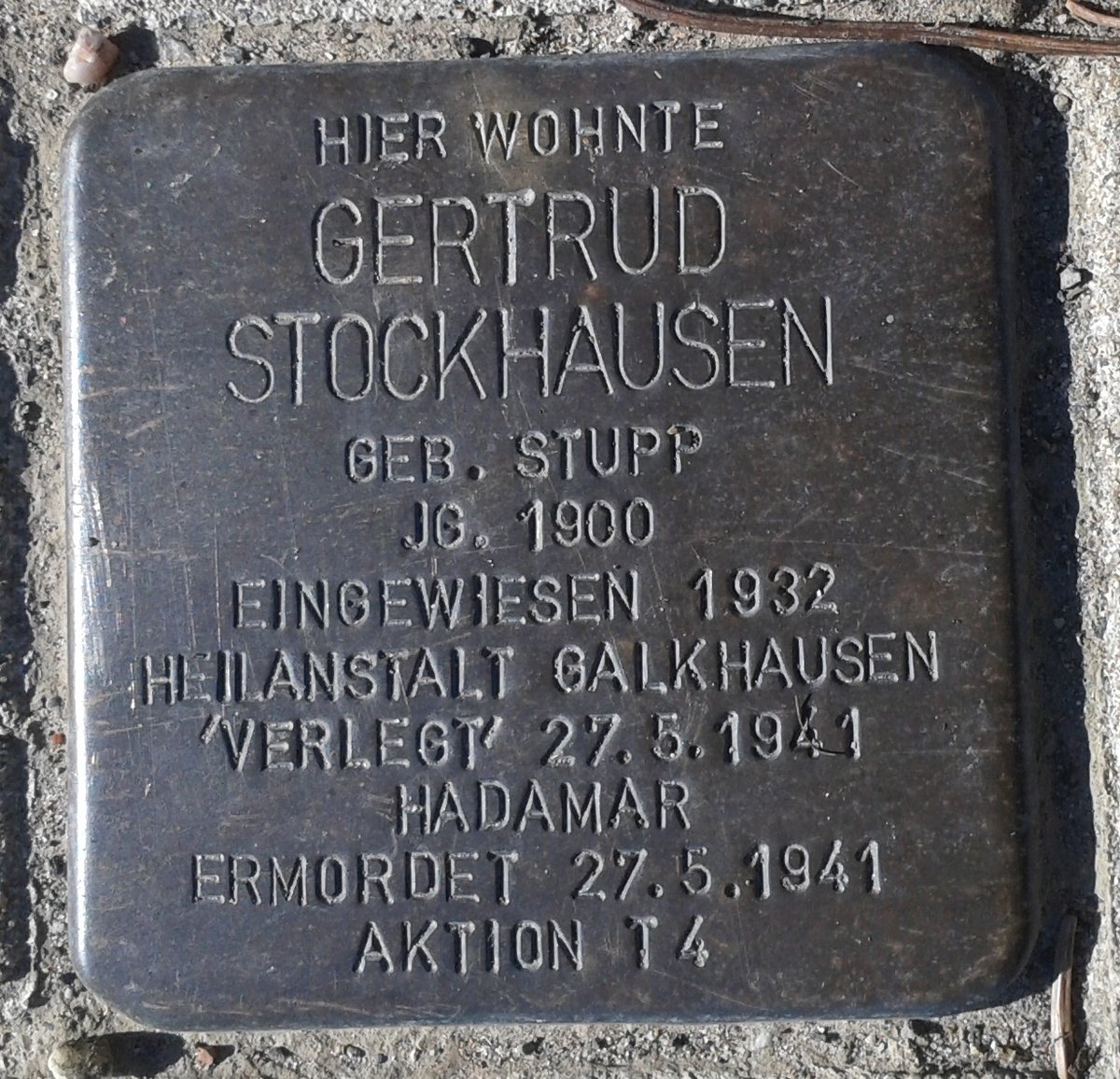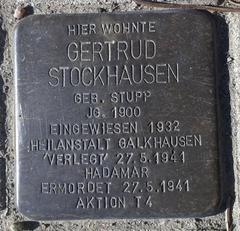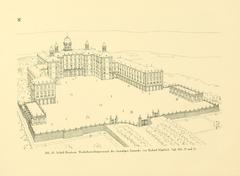
Stolperstein Gertrud Stockhausen Bergisch Gladbach: Visiting Hours, Tickets, and History
Date: 14/06/2025
Introduction
The Stolperstein dedicated to Gertrud Stockhausen in Bergisch Gladbach is a deeply moving memorial, intertwining the personal tragedy of one individual with the collective memory of Nazi persecution. Stolpersteine, or “stumbling stones,” are small brass plaques set into the sidewalks across Europe, commemorating victims of the National Socialist regime from 1933 to 1945. Conceived by German artist Gunter Demnig in 1992, the project has grown into the world’s largest decentralized memorial with more than 90,000 stones in over 1,800 towns and cities across 28 countries. Each Stolperstein is placed at the last freely chosen residence of a victim, restoring names and stories to those whom history sought to erase (bergischgladbach.de; de.wikipedia.org).
Gertrud Stockhausen, mother of composer Karlheinz Stockhausen, was murdered in 1941 at the Hadamar killing center under the Nazi euthanasia program. Her Stolperstein in Bergisch Gladbach’s Bärbroich district stands as a testament to her life and the countless others lost to Nazi atrocities. The installation, realized in 2014 after local research and advocacy, represents how communities reclaim, preserve, and honor silenced histories. Visitors to this Stolperstein engage in a reflective journey, supported by the site’s accessibility and integration in the urban landscape. Bergisch Gladbach also offers related historical sites and educational resources that deepen understanding of the Holocaust and the importance of remembrance (pfarr-rad.de; in-gl.de; rheinland-pilgern.de).
This article provides practical information for visitors—including location, accessibility, and travel tips—alongside historical context and suggestions for meaningful engagement with the memorial and related sites. Whether you seek personal connection to the stories of the Holocaust or wish to participate in acts of remembrance, this guide will help you plan a respectful and enlightening visit.
Table of Contents
- Stolpersteine Project: Origins and Purpose
- Victim Groups and Commemorative Scope
- Artistic, Social, and Educational Impact
- Stolpersteine in Bergisch Gladbach: Local Context
- Symbolism and Ethical Dimensions
- Visiting the Stolperstein for Gertrud Stockhausen
- Practical Visitor Information: Hours, Access, and Tours
- Nearby Attractions and Related Memorials
- Frequently Asked Questions (FAQ)
- Conclusion and Call to Action
Stolpersteine Project: Origins and Purpose
The Stolpersteine project began with Gunter Demnig’s personal commitment to making the memory of Nazi victims visible in daily life. The first stones were laid in Cologne in 1992, and the project soon took root throughout Germany and Europe. Stolpersteine are 10 x 10 cm brass-plated concrete cubes, installed in the pavement in front of victims’ last freely chosen residences (in-gl.de; bergischgladbach.de).
The philosophy is personal remembrance: instead of centralized, monumental memorials, Stolpersteine are modest, decentralized, and embedded in everyday environments. Reading the names often requires a bow of the head, a symbolic act of respect and remembrance. Demnig has noted, “You don’t trip and fall over a Stolperstein, you stumble with your head and your heart” (in-gl.de).
Victim Groups and Commemorative Scope
Stolpersteine honor a diverse range of Nazi victims: Jews, Sinti and Roma, political dissidents, homosexuals, Jehovah’s Witnesses, people with disabilities, and others. Each stone is engraved with the person’s name, date of birth, fate, and, if known, date and place of death (tracesofwar.com; bergischgladbach.de). Their decentralized placement highlights the widespread reach of Nazi crimes and the diversity of those affected. In Bergisch Gladbach, Stolpersteine can be found in districts like Bärbroich, Schildgen, Heidkamp, and Gronauer Waldsiedlung (bergischgladbach.de).
Artistic, Social, and Educational Impact
Stolpersteine function as both art and grassroots historical education. Embedded in public space, they challenge the idea that memory should be confined to museums or official memorials. The project often inspires local remembrance ceremonies, educational initiatives, and family research. For example, Gertrud Stockhausen’s Stolperstein was installed after research by local student Lisa Quernes, ensuring her story is not forgotten (bergischgladbach.de).
Schools and community groups frequently organize guided walks or research projects around local Stolpersteine, fostering deeper understanding of the Holocaust’s impact on individuals and communities (pfarr-rad.de).
Stolpersteine in Bergisch Gladbach: Local Context
Bergisch Gladbach, in North Rhine-Westphalia, has embraced Stolpersteine as key components of its historical memory. As of 2025, at least eight stones have been installed, each marking a victim’s last residence (de.wikipedia.org). The stone for Gertrud Stockhausen at Bärbroich 17 is especially significant due to her tragic fate and her connection to composer Karlheinz Stockhausen. The city supports the project through archives, schools, and civic organizations, ensuring each story is remembered and shared (bergischgladbach.de).
Symbolism and Ethical Dimensions
Stolpersteine resist the erasure and anonymization that characterized Nazi policies. By naming victims and placing their memories in the spaces they once inhabited, the project reaffirms individual identity and humanity. Encountering a Stolperstein is intentionally unsettling, prompting reflection on intolerance, indifference, and authoritarianism. These memorials are not only markers of loss but calls to vigilance and ethical responsibility (pfarr-rad.de).
Visiting the Stolperstein for Gertrud Stockhausen
Location and Access
The Stolperstein for Gertrud Stockhausen is located in the Bärbroich district of Bergisch Gladbach, set into the pavement in front of her former residence (Kölner Stadt-Anzeiger; rheinland-pilgern.de). The exact address is featured on local Stolperstein maps and guides. The site is fully accessible to pedestrians and wheelchair users.
Installation and Ceremony
Installed on February 7, 2014, by Gunter Demnig, the Stolperstein bears the inscription:
“Hier wohnte Gertrud Stockhausen, geb. Stupp, Jg. 1900, deportiert 1941 Hadamar, ermordet 27.5.1941”
(“Here lived Gertrud Stockhausen, née Stupp, born 1900, deported 1941 Hadamar, murdered 27.5.1941”)
The ceremony was attended by family, residents, and city officials, including Mayor Lutz Urbach, who emphasized the importance of remembrance.
Practical Visitor Information: Hours, Access, and Tours
- Visiting Hours: The Stolperstein is outdoors in a public area and can be visited at any time. Daytime hours are recommended for safety and reflection.
- Tickets/Entry Fee: None; access is free.
- Accessibility: The site is flush with the sidewalk and accessible for those with mobility needs.
- Public Transport: Take the S-Bahn S11 from Cologne to Bergisch Gladbach, then local bus lines to Bärbroich. A short walk leads to the Stolperstein.
- Parking: Limited street parking is available; using public transport is recommended.
- Guided Tours: Periodic guided tours are offered by local organizations; check with the city archive or tourism office for schedules.
- Photography: Allowed; please be respectful, especially during ceremonies.
Visitor Tips:
- Wear comfortable shoes and prepare for outdoor weather.
- Bringing a flower or pebble is a thoughtful gesture.
- On remembrance days (e.g., January 27, International Holocaust Remembrance Day), join local cleaning or commemorative events (Folklife Magazine).
Historical Context
Gertrud Stockhausen, born in 1900, was institutionalized in 1932 and murdered in 1941 at the Hadamar killing center under Aktion T4, the Nazi euthanasia program targeting people with disabilities (Kölner Stadt-Anzeiger; rheinland-pilgern.de). Her Stolperstein is a lasting tribute to her life and a reminder of those lost to Nazi violence.
Nearby Attractions and Related Memorials
Bergisch Gladbach hosts several other Stolpersteine, each honoring a victim of the Nazi regime. Exploring these sites—often included in local walking tours—offers a broader perspective on the city’s history (rheinland-pilgern Stolperstein Tour). Local museums and archives also provide deeper insights into World War II history in the region.
Frequently Asked Questions (FAQ)
Q: Do I need tickets to visit the Stolperstein?
A: No, access is free and open at all times.
Q: Are guided tours available?
A: Yes, check with local museums, schools, or the city archive for periodic guided tours.
Q: Is the site accessible?
A: Yes, the Stolperstein is flush with the pavement and accessible to wheelchair users.
Q: Can I participate in remembrance events?
A: Yes, join local cleaning efforts or attend ceremonies on Holocaust remembrance days.
Q: Are there other Stolpersteine nearby?
A: Yes, multiple Stolpersteine are located throughout Bergisch Gladbach, offering opportunities for further exploration.
Conclusion and Call to Action
Visiting the Stolperstein dedicated to Gertrud Stockhausen is a powerful act of remembrance and reflection. By engaging thoughtfully and respectfully, visitors help preserve the dignity and humanity of those lost during the Nazi era. Use available guides, maps, and digital tools like the Audiala app to enhance your visit and understanding. Participate in local remembrance activities and explore the broader network of Stolpersteine in Bergisch Gladbach to deepen your connection to history.
For more information, download the Audiala app and follow our social media channels. Continue exploring Bergisch Gladbach’s historical sites and support the mission of remembrance and human rights.
Further Information and Resources
- Kölner Stadt-Anzeiger: Gertrud Stockhausen Stolperstein
- Rheinland-Pilgern: Stolperstein Bärbroich
- Germany.info: Stolpersteine
- Folklife Magazine: Stumbling Stones
- bergischgladbach.de
- de.wikipedia.org
- in-gl.de
- pfarr-rad.de
Internal Links:
- [Explore Other Holocaust Memorials in Bergisch Gladbach]
- [Bergisch Gladbach Travel Guide]
- [Understanding the Aktion T4 Program]
Map:
Image Suggestions:
- Photo of the Stolperstein Gertrud Stockhausen embedded in the pavement (alt text: “Stolperstein Gertrud Stockhausen Bergisch Gladbach”)
- Map screenshot showing Stolperstein locations in Bergisch Gladbach
- Event photos from remembrance day ceremonies (if available)
Final Thoughts
The Stolperstein for Gertrud Stockhausen stands as a poignant symbol of individual memory within the broader tragedy of Nazi persecution. Its presence in Bärbroich honors Gertrud’s life and death, while exemplifying the Stolpersteine project’s mission to embed remembrance in the everyday world. Visitors are invited to reflect quietly, participate in local remembrance, and explore the historical context that gives these memorials profound meaning.
By visiting, learning, and sharing, you help keep the stories and lessons of the past alive for future generations (bergischgladbach.de; folklife.si.edu; rheinland-pilgern.de).

